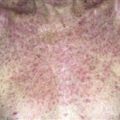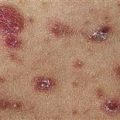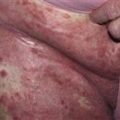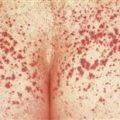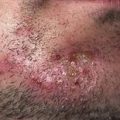158
Acquired cutaneous paraneoplastic syndromes
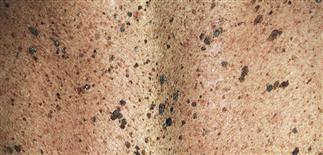
Sign of Leser–Trélat: the sudden appearance or increase in number and size of seborrheic keratosis on non-inflamed skin has been reported to be a sign of internal malignancy.
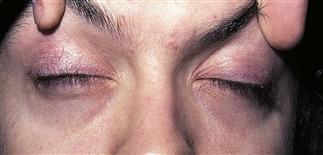
Dermatomyositis: heliotrope erythema of the eyelids (heliotrope: violet) can be paraneoplastic condition. This can be misdiagnosed as eyelid dermatitis.
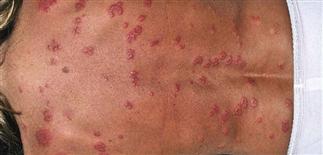
Sweet syndrome. Acute tender erythematous plaques and pseudovesicles, and occasional blisters.

Paraneoplastic pemphigus. Widespread polymorphous eruption with papules and blisters. There were painful oral ulcerations. Total resection of the neoplasm may cure the disease.
Involve cutaneous findings attributed to internal malignancy.
PRURITUS
• Symptom of many dermatoses, but in absence of skin findings may indicate occult malignancy. • More common in gastrointestinal and lymphoreticular malignancies, especially Hodgkin disease. • May not be associated with obvious skin changes. • Patients may scratch or may show linear erosions or excoriations distributed in reachable areas.
SIGN OF LESER–TRÉLAT
• Sudden, eruptive appearance of numerous seborrheic keratoses may indicate internal malignancy. Exceedingly rare and ominous entity known as sign of Leser–Trélat. • Adenocarcinoma of gastrointestinal tract is most common. • Lesions generalized, small, inflamed, monomorphic keratoses.
DERMATOMYOSITIS
• Adults with dermatomyositis more likely to have internal malignancy than age-matched controls. • Prevalence estimated at 5–50%, with greatest prevalence among older patients. • Most common associated malignancies are in breast, ovary, lung, gastrointestinal system. • Dermatomyositis may be associated with proximal muscle weakness. • Findings of dermatomyositis include Gottron’s papules, periocular heliotrope or violaceous discoloration, photosensitive violaceous eruption, poikiloderma, periungual telangiectasia.
SWEET SYNDROME
• Also called acute febrile neutrophilic dermatosis. • Recurrent, painful eruption associated with fever, leukocytosis, arthralgias. • Women affected more commonly. • May be associated with infection or with hematologic malignancy, most often acute myelogenous leukemia. • Lesions red, edematous, pseudovesicular plaques, coalescing papules. Vary from 0.5 to 5.0 cm, tender to palpation.
PARANEOPLASTIC PEMPHIGUS
• Presents as sign of internal malignancy, most often hematologic and chronic lymphocytic leukemia. • Paraneoplastic pemphigus presents as ocular inflammation, oral erosions, generalized erythema multiforme-like bullous lesions, denuded areas with crusting.
CARCINOID SYNDROME
• Episodic, intense flushing of face, neck, upper body, caused by release of vasoactive mediators from carcinoid tumors into systemic circulation. • Most arise in small bowel, usually appendix. May also arise in lung. • When carcinoid tumors metastasize to liver, mediators have access to systemic circulation. • Carcinoid syndrome presents as acute flushing of face, neck, chest lasting about 30 min. Flushing episodes often associated with dyspnea, abdominal cramping, diarrhea.
GLUCAGONOMA SYNDROME
• Rare, clinically distinctive syndrome consisting of a dynamic generalized cutaneous eruption associated with a glucagon-secreting alpha-cell tumor of pancreas. • Necrolytic migratory erythema describes eruption of glucagonoma syndrome. Eruption generalized but favors groin, buttocks, thighs. Bright dermal erythema is polycyclic, followed by flaccid bullae that desquamate, leaving denuded areas and collarette of scale. Process is dynamic, changing, extending each day.

